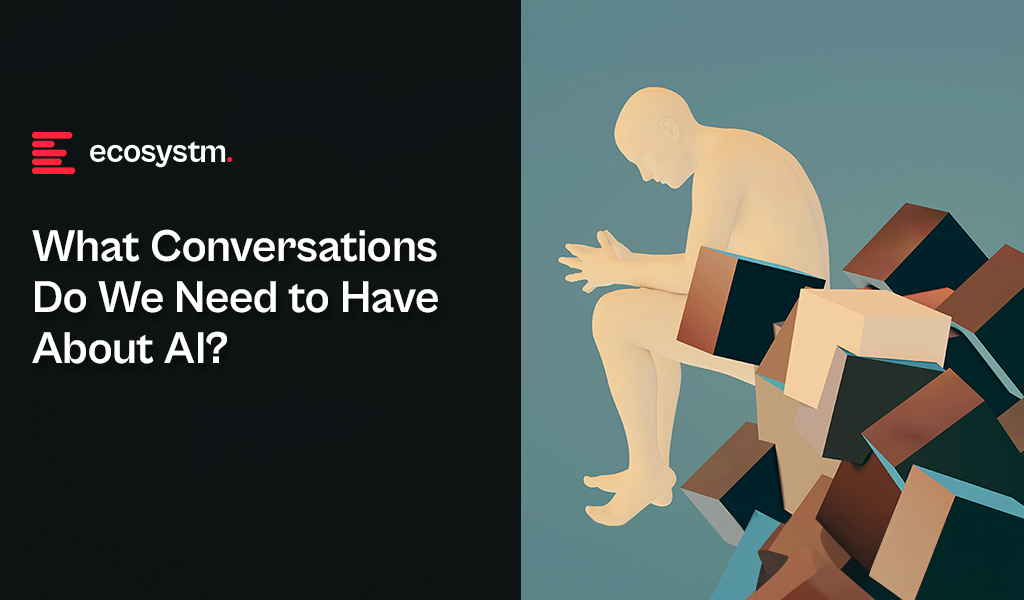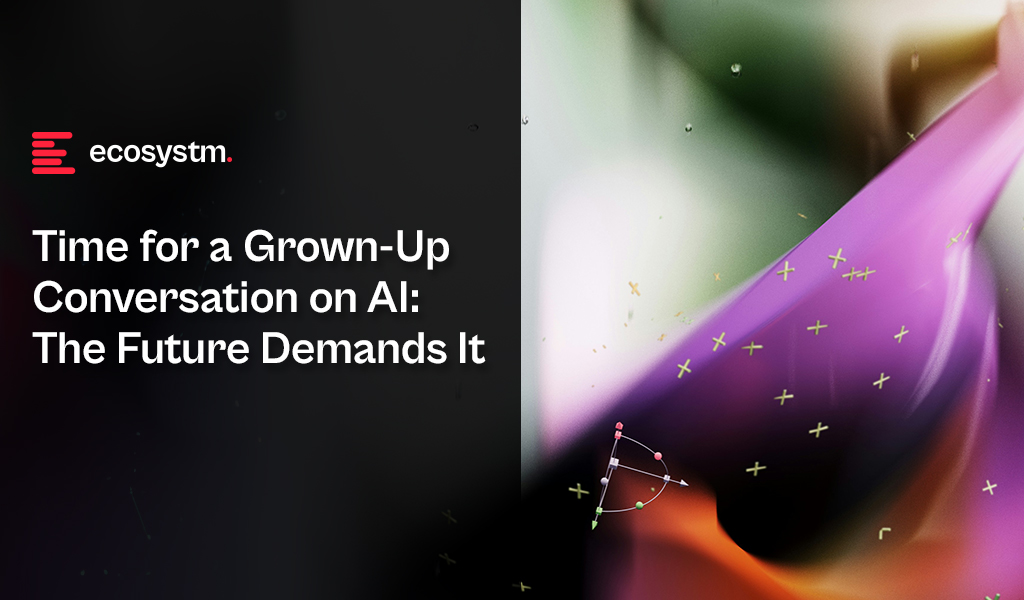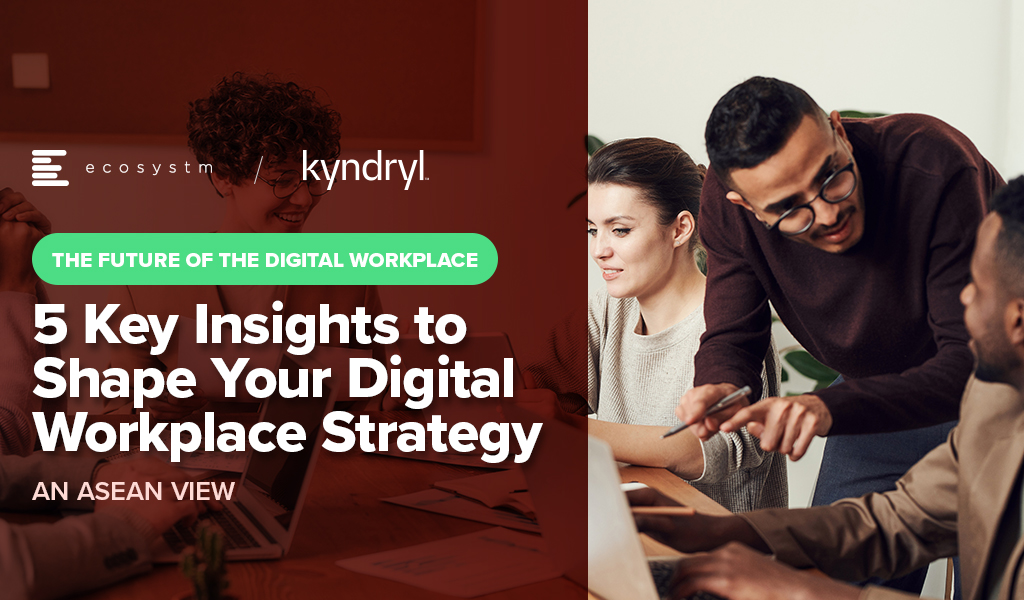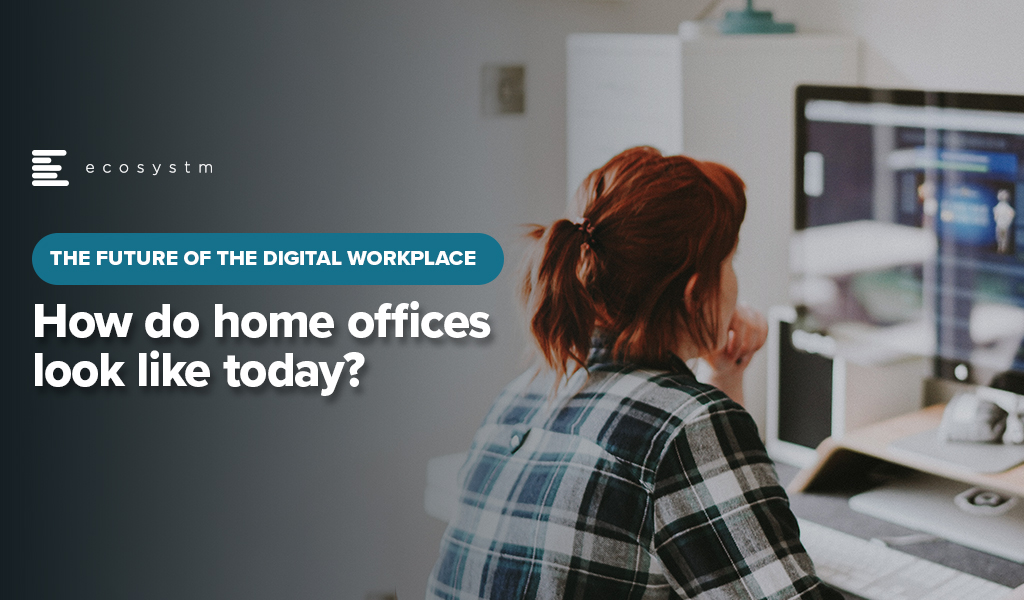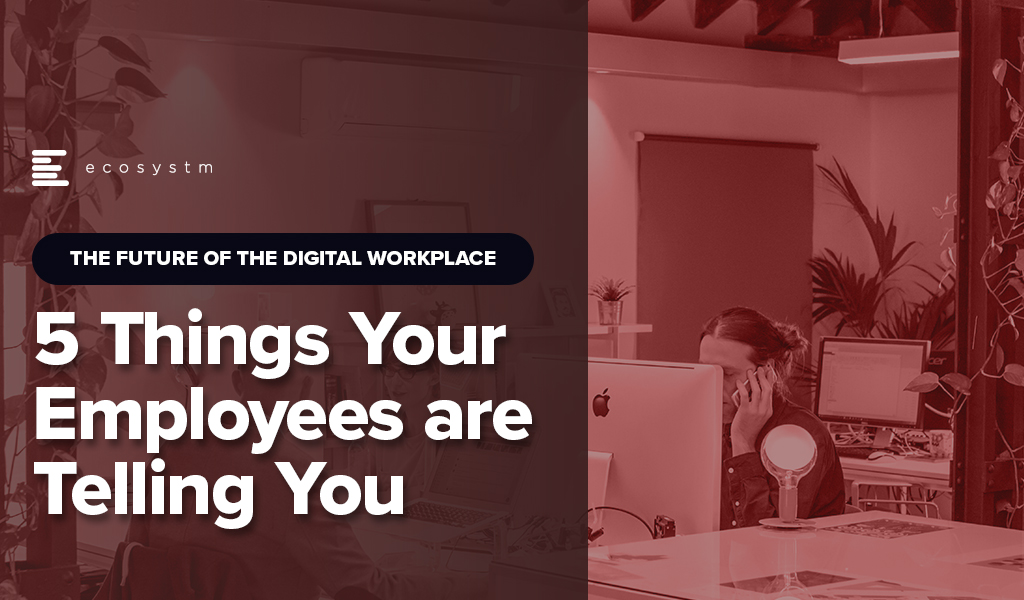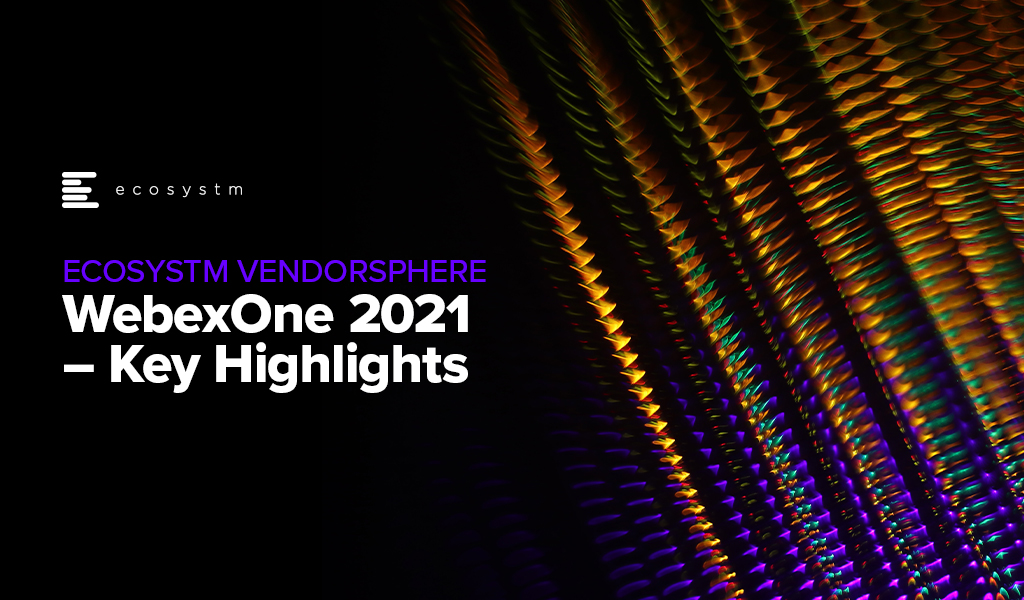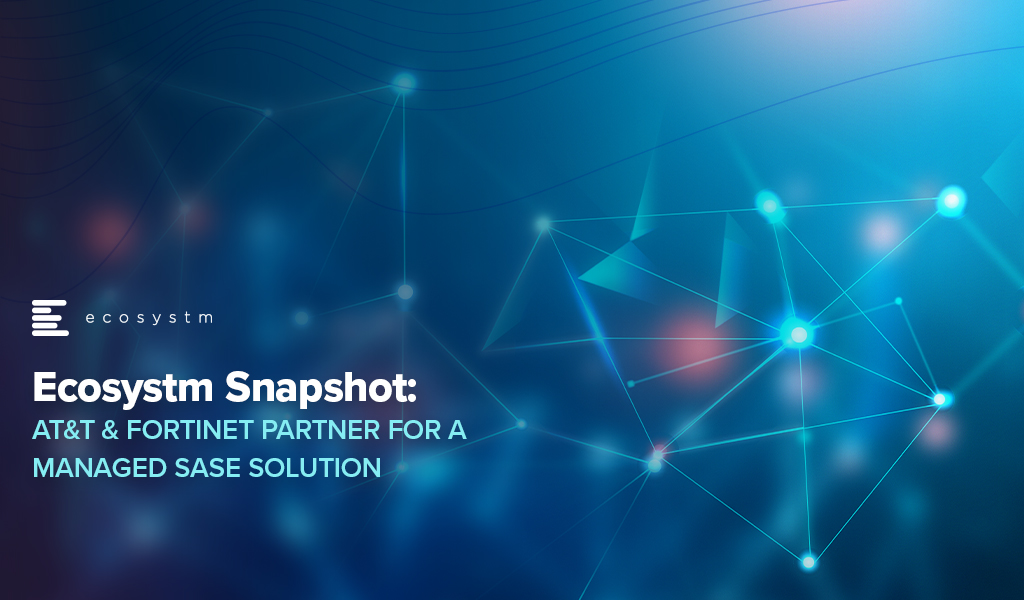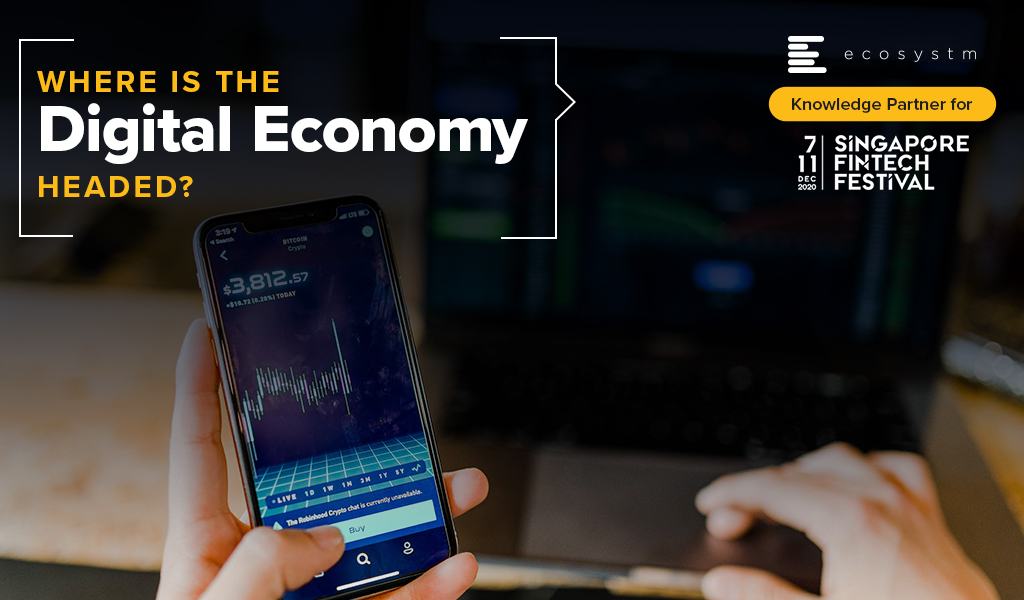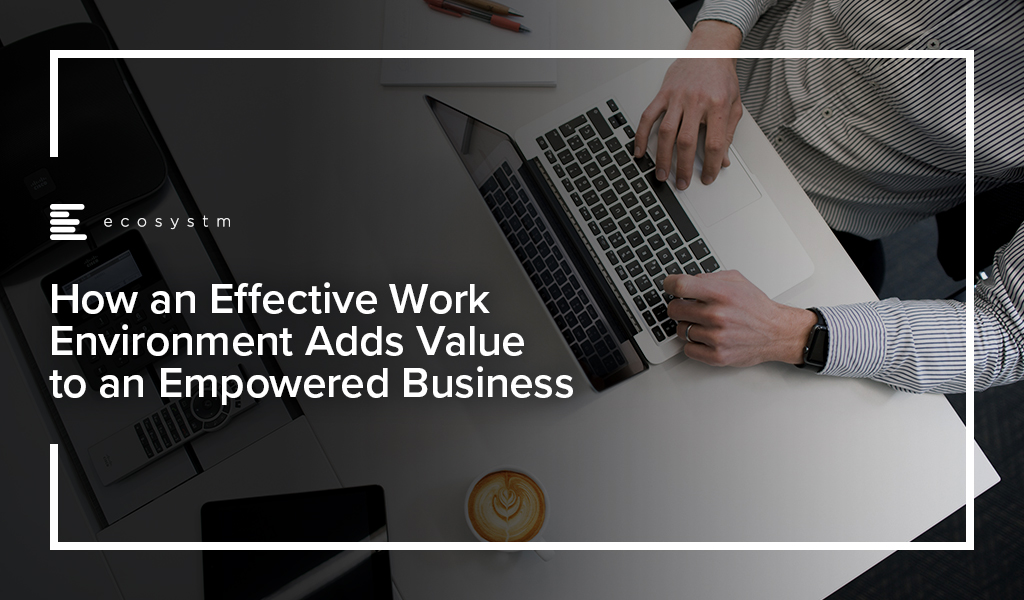In my earlier post this week, I referred to the need for a grown-up conversation on AI. Here, I will focus on what conversations we need to have and what the solutions to AI disruption might be.
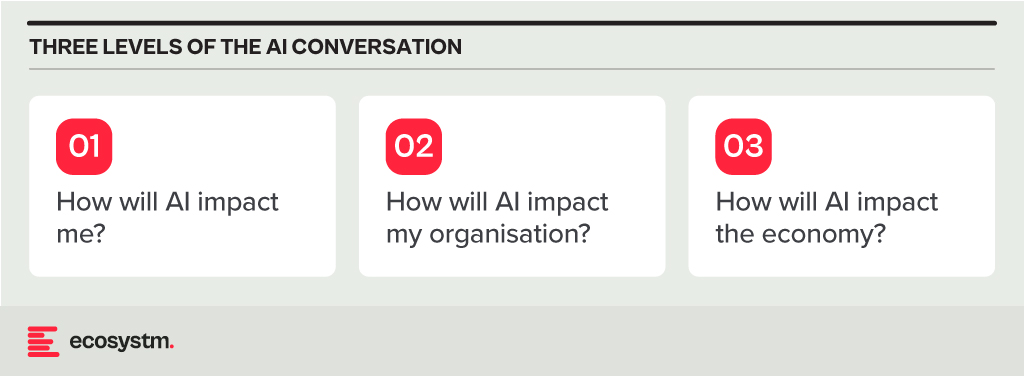
The Impact of AI on Individuals
AI is likely to impact people a lot! You might lose your job to AI. Even if it is not that extreme, it’s likely AI will do a lot of your job. And it might not be the “boring bits” – and sometimes the boring bits make a job manageable! IT helpdesk professionals, for instance, are already reporting that AIOps means they only deal with the difficult challenges. While that might be fun to start with, some personality types find this draining, knowing that every problem that ends up in the queue might take hours or days to resolve.
Your job will change. You will need new skills. Many organisations don’t invest in their employees, so you’ll need to upskill yourself in your own time and at your own cost. Look for employers who put new skill acquisition at the core of their employee offering. They are likelier to be more successful in the medium-to-long term and will also be the better employers with a happier workforce.
The Impact of AI on Organisations
Again – the impact on organisations will be huge. It will change the shape and size of organisations. We have already seen the impact in many industries. The legal sector is a major example where AI can do much of the job of a paralegal. Even in the IT helpdesk example shared earlier, where organisations with a mature tech environment will employ higher skilled professionals in most roles. These sectors need to think where their next generation of senior employees will come from, if junior roles go to AI. Software developers and coders are seeing greater demand for their skills now, even as AI tools increasingly augment their work. However, these skills are at an inflection point, as solutions like TuringBots have already started performing developer roles and are likely to take over the job of many developers and even designers in the near future.
Some industries will find that AI helps junior roles act more like senior employees, while others will use AI to perform the junior roles. AI will also create new roles (such as “prompt engineers”), but even those jobs will be done by AI in the future (and we are starting to see that).
HR teams, senior leadership, and investors need to work together to understand what the future might look like for their organisations. They need to start planning today for that future. Hint: invest in skills development and acquisition – that’s what will help you to succeed in the future.
The Impact of AI on the Economy
Assuming the individual and organisational impacts play out as described, the economic impacts of widespread AI adoption will be significant, similar to the “Great Depression”. If organisations lay off 30% of their employees, that means 30% of the economy is impacted, potentially leading to drying up of some government and an increase in government spend on welfare etc. – basically leading to major societal disruption.
The “AI won’t displace workers” narrative strikes me as the technological equivalent of climate change denial. Just like ignoring environmental warnings, dismissing the potential for AI to significantly impact the workforce is a recipe for disaster. Let’s not fall into the same trap and be an “AI denier”.
What is the Solution?
The solutions revolve around two ideas, and these need to be adopted at an industry level and driven by governments, unions, and businesses:
- Pay a living salary (for all citizens). Some countries already do this, with the Nordic nations leading the charge. And it is no surprise that some of these countries have had the most consistent long-term economic growth. The challenge today is that many governments cannot afford this – and it will become even less affordable as unemployment grows. The solution? Changing tax structures, taxing organisational earnings in-country (to stop them recognising local earnings in low-tax locations), and taxing wealth (not incomes). Also, paying essential workers who will not be replaced by AI (nurses, police, teachers etc.) better salaries will also help keep economies afloat. Easier said than done, of course!
- Move to a shorter work week (but pay full salaries). It is in the economic interest of every organisation that people stay gainfully employed. We have already discussed the ripple effect of job cuts. But if employees are given more flexibility, and working 3-day weeks, this not only spreads the work around more workers, but means that these workers have more time to spend money – ensuring continuing economic growth. Can every company do this? Probably not. But many can and they might have to. The concept of a 5-day work week isn’t that old (less than 100 years in fact – a 40-hour work week was only legislated in the US in the 1930s, and many companies had as little as 6-hour working days even in the 1950s). Just because we have worked this way for 80 years doesn’t mean that we will always have to. There is already a move towards 4-day work weeks. Tech.co surveyed over 1,000 US business leaders and found that 29% of companies with 4-day workweeks use AI extensively. In contrast, only 8% of organisations with a 5-day workweek use AI to the same degree.
AI Changes Everything
We are only at the beginning of the AI era. We have had a glimpse into the future, and it is both frightening and exciting. The opportunities for organisations to benefit from AI are already significant and will become even more as the technology improves and businesses learn to better adopt AI in areas where it can make an impact. But there will be consequences to this adoption. We already know what many of those consequences will be, so let’s start having those grown-up conversations today.

If you have seen me present recently – or even spoken to me for more than a few minutes, you’ve probably heard me go on about how the AI discussions need to change! At the moment, most senior executives, board rooms, governments, think tanks and tech evangelists are running around screaming with their hands on their ears when it comes to the impact of AI on jobs and society.
We are constantly being bombarded with the message that AI will help make knowledge workers more productive. AI won’t take people’s jobs – in fact it will help to create new jobs – you get the drift; you’ve been part of these conversations!
I was at an event recently where a leading cloud provider had a huge slide with the words: “Humans + AI Together” in large font across the screen. They then went on to demonstrate an opportunity for AI. In a live demo, they had the customer of a retailer call a store to check for stock of a dress. The call was handled by an AI solution, which engaged in a natural conversation with the customer. It verified their identity, checked dress stock at the store, processed the order, and even confirmed the customer’s intent to use their stored credit card.
So, in effect, on one slide, the tech provider emphasised that AI was not going to take our jobs, and two minutes later they showed how current AI capabilities could replace humans – today!
At an analyst event last week, representatives from three different tech providers told analysts how Microsoft Copilot is freeing up 10-15 hours a week. For a 40-hour work week, that’s a 25-38 time saving. In France (where the work week is 35 hours), that’s up to 43% of their time saved. So, by using a single AI platform, we can save 25-43% of our time – giving us the ability to work on other things.
What are the Real Benefits of AI?
The critical question is: What will we do with this saved time? Will it improve revenue or profit for businesses? AI might make us more agile, faster, more innovative but unless that translates to benefits on the bottom line, it is pointless. For example, adopting AI might mean we can create three times as many products. However, if we don’t make any more revenue and/or profit by having three times as many products, then any productivity benefit is worthless. UNLESS it is delivered through decreased costs.
We won’t need as many humans in our contact centres if AI is taking calls. Ideally, AI will lead to more personalised customer experiences – which will drive less calls to the contact centre in the first place! Even sales-related calls may disappear as personal AI bots will find deals and automatically sign us up. Of course, AI also costs money, particularly in terms of computing power. Some of the productivity uplift will be offset by the extra cost of the AI tools and platforms.
Many benefits that AI delivers will become table stakes. For example, if your competitor is updating their product four times a year and you are updating it annually, you might lose market share – so the benefits of AI might be just “keeping up with the competition”. But there are many areas where additional activity won’t deliver benefits. Organisations are unlikely to benefit from three times more promotional SMSs or EDMs and design work or brand redesigns.
I also believe that AI will create new roles. But you know what? AI will eventually do those jobs too. When automation came to agriculture, workers moved to factories. When automation came to factories, workers moved to offices. The (literally) trillion-dollar question is where workers go when automation comes to the office.
The Wider Impact of AI
The issue is that very few senior people in businesses or governments are planning for a future where maybe 30% of jobs done by knowledge workers go to AI. This could lead to the failure of economies. Government income will fall off a cliff. It will be unemployment on levels not seen since the great depression – or worse. And if we have not acknowledged these possible outcomes, how can we plan for it?
This is what I call the “grown up conversation about AI”. This is acknowledging the opportunity for AI and its impacts on companies, industries, governments and societies. Once we acknowledge these likely outcomes we can plan for it.
And that’s what I’ll discuss shortly – look out for my next Ecosystm Insight: The Three Possible Solutions for AI-driven Mass Unemployment.

For the last two years organisations have been forced to invest on digital services for their customers and giving their employees access to the right technologies to allow them to work from home – or from anywhere they choose to. Organisations find that they have to continue to evolve – and are now looking to build a ‘Digital Workplace’ that caters to the hybrid workplace.
As organisations in ASEAN define the work model that works for their business operations, work culture and organisational goals, there are a few areas that they must focus on.
Here are 5 insights from the Ecosystm Voice of the Employee Study that will help you shape your Digital Workplace.
- Evolve the physical workplace. 72% of knowledge workers in ASEAN will work both remotely and from the office.
- Build a true hybrid work culture. As organisations form their Digital Workplace strategy, they will have to ensure that the workplace is as comfortable as home offices!
- Focus on employee wellbeing. Only 25% of organisations in ASEAN have made changes to their HR policies in the last two years.
- Invest in the right technologies. To build that resilient hybrid workplace, organisations will first have to conduct a gap analysis and consolidation of their tech investments over the last two years.
- Continue to monitor employee behaviour patterns. As organisations work towards a ‘Return to Work’ policy, they will see significant changes in employee usage behaviour patterns. If the right cyber practices are not in place, this could leave organisations vulnerable again.
Read on for more insights

The Ecosystm Voice of the Employee Study reveals that 76% of your employees have a dedicated home office, which they have continually enhanced over the last two years. Now that you are working to bring these employees back to the office, are you focusing on giving them the same technology and environment that they have become used to?
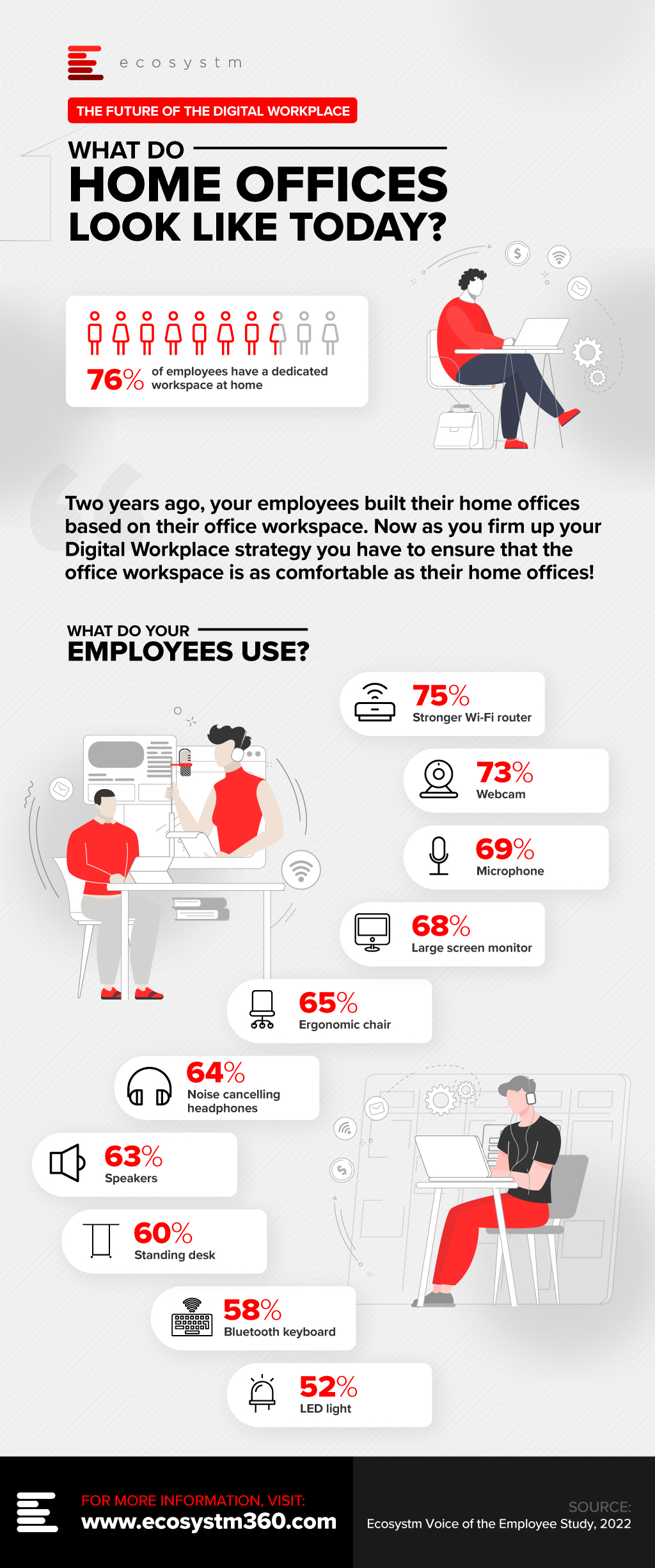
Download the Ecosystm Voice of Employee Study infographic as a PDF

At Ecosystm we pride ourselves in keeping a finger on the pulse of the market. There is a lot of buzz around the ‘Digital Workplace’. For the last two years you have focused on technologies that allow employees to work from home – or from anywhere they choose to. Now the focus of the tech investments is on empowering employees to return to the physical office and creating a true hybrid workplace.
As you define the work model that works for your organisation, now is the time to listen to your employees. The newly launched Ecosystm Voice of the Employee Study aims to do just that.
The study aims to explore the emerging global Future of Work trends from an employee’s point-of-view. In an environment of uncertainty, this is designed to be an ongoing, dynamic study that will be able to track the major shifts in preferences, perceptions, and practices over the year.
Here are some key findings from the ongoing study.
- 2022 will be another year of flux – The Great Resignation may well impact you.
- You may not be giving enough choices to your employees
- It is time to get your workplace ready – and embrace a hybrid work model
- Your employees are more tech-savvy than even before
- Employee Experience will have to remain a priority
Read on to find more about the study findings.
Click here to download the Future of the Digital Workplace as a PDF

Cisco’s annual WebexOne conference was held on 26-27 October featuring over 30 sessions with thought leaders, guest speakers, technology partners and Cisco executives. This year’s event focused on how the company and its ecosystem of partners will continue to enable the Future of Work.
In the last year, Cisco has added more than 1,000 features to its Webex platform and made 5 key acquisitions. But from the event, it became apparent that the company is continuing to work on product differentiation and making hybrid work a more productive and human experience.
Read on to find what Ecosystm analysts, Audrey William, Sash Mukherjee, Tim Sheedy, Ullrich Loeffler and Venu Reddy found interesting about the announcements at WebexOne 2021.
To download this VendorSphere as a pdf for easier sharing, please click here.
Last week AT&T announced a partnership with Fortinet to expand their managed security services portfolio. This partnership provides global managed Secure Access Service Edge (SASE) solutions at scale. The solution uses Fortinet’s SASE stack which unifies software-defined wide-area network (SD-WAN) and network security capabilities into AT&T managed cybersecurity framework. Additionally, AT&T SASE and Fortinet will integrate with AT&T Alien Labs Threat Intelligence platform, a threat intelligence unit to enhance detection and response. AT&T has plans to update its managed SASE service during the year and will continue to bring more options.
Talking about the AT&T-Fortinet partnership, Ecosystm Principal Advisor, Ashok Kumar says, “This move continues the trend of the convergence of networking and security solutions. AT&T is positioning themselves well with their integrated offer of network and security services to address the needs of global enterprises.”
Convergence of Network & Security
AT&T’s improved global managed security service includes features such as secure web gateway, firewall-as-a service, cloud access security broker (CASB) and zero-trust access, which provides security teams and analysts with unified capabilities across the cloud, networks and endpoints. The solution aims to enable enterprises to create a more resilient network bringing the core capabilities of the two companies that will reduce operational costs and deliver a unified offering.
Last year AT&T also partnered with Cisco to expand its SD-WAN solution and to support AT&T Managed Services using Cisco’s vManage controller through a single management interface. Over the past years multiple vendors including Fortinet have developed comprehensive SASE solution capabilities through partnerships or acquisitions to provide a unified offering. Last year Fortinet acquired Opaq, a SASE cloud provider to bolster their security capabilities through OPAQ’s patented Zero Trust Network Access (ZTNA) cloud solution and to strengthen SD-WAN, security and edge package.
The Push Towards Flexible Networking
Kumar says, “The pandemic has created a higher demand and value for secure networking services. Enterprises experienced greater number of phishing and malware attacks last year with the sudden increase in work-from-home users. The big question enterprises need to ask themselves is whether legacy networks can support their evolving business priorities.”
“As global economies look to recover, securing remote users working from anywhere, with full mobility, will be a high priority for all enterprises. Enterprises need to evaluate mobile SASE services that provide frictionless identity management with seamless user experiences, and be compatible with the growing adoption of 5G services in 2021 and beyond.”
The Top 5 Telecommunications & Mobility Trends that will dominate the telecom industry to watch out for in 2021. Signup for Free to download the report.

In this blog, our guest authors Randeep Sudan and Yamin Oo talk about the pervasiveness of the Digital Economy, and the key trends that will determine its future trajectory. “That the world in 2030 will be very different from today is obvious. We may, however, be surprised by the extent and sweep of the change ahead of us.”


The Digital Economy – a term first coined by Don Tapscott in 1994 – is not easy to define or measure. At one end, it is limited to the production and consumption of digital goods and services. On the other end, according to the European Parliament, “The digital economy is increasingly interwoven with the physical or offline economy making it more and more difficult to clearly delineate the digital economy“. We are, however, witnessing the Digital Economy transitioning to an economy that is digital.
Given the pervasiveness of the Digital Economy, its future will be determined by the complex interplay of several trends. Some of the trends that illustrate the future trajectory of the Digital Economy are:
Technology
We will see AI becoming ubiquitous as it is leveraged in every sector and sphere of activity. According to one estimate, AI is estimated to contribute USD 15.7 trillion to the global economy by 2030, which is more than the current GDP of China and India combined! We are also likely to see rapid progress in technologies related to Extended Reality (XR) in the coming years. COVID-19 is accelerating this trend, as we can see from the offerings of companies like Spatial and MeetinVR that facilitate virtual business meetings. The analog world’s rendering into its digital twin will see us moving towards a metaverse – a virtual shared space imagined in Neal Stephenson’s novel Snowcrash. Some of the biggest names in the tech industry – Apple (Apple glass), Facebook (Oculus), Sony (Playstation) – are assiduously working towards this direction.
Given the importance of telecom infrastructure to the Digital Economy, 5G networks are being rolled out in countries worldwide (Figure 1). However, even as 5G is being deployed, the buzz around 6G is getting louder. 6G may transmit data 100 times faster than 5G and may see deployment by 2030 given the decadal cycles for telecom: 1G in the 80s, 2G in the 90s, 3G in the decade following 2000, 4G in the decade starting 2010, and 5G beginning in the 2020s.
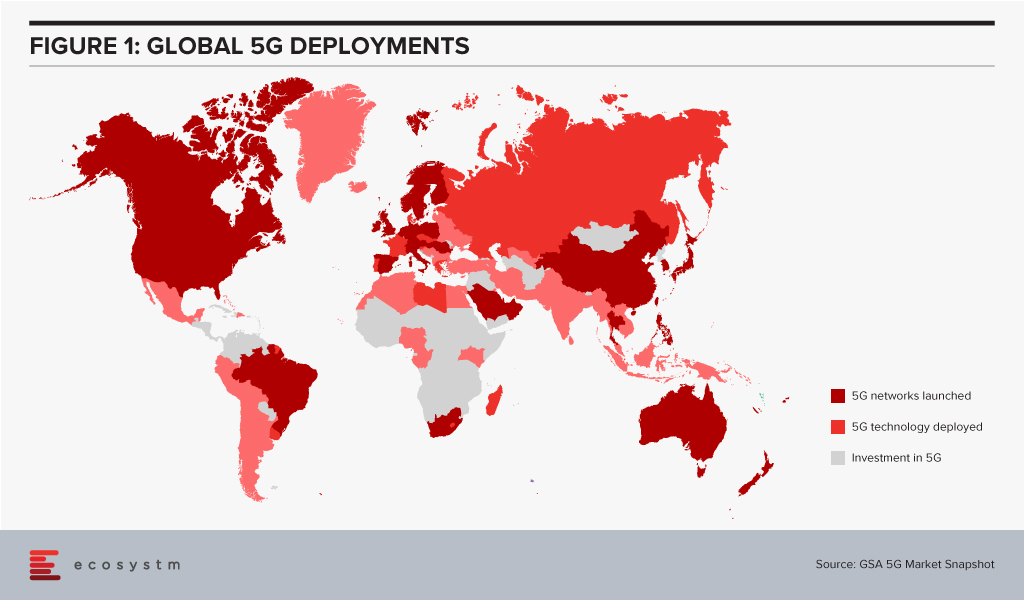
The availability of high bandwidth, low latency networks could lead to newer applications and further breakthroughs in innovative technologies.
The Future of Work
With the rapid growth in automation and AI, we are likely to see significant labour market disruptions. Moreover, COVID-19 has been a watershed for the global economy – its impacts will continue to be felt for many years to come. According to the International Labor Organization, 495 million full-time jobs were lost in the first two quarters of 2020 due to COVID-19. Lower and middle-income countries have suffered the most, with an estimated 23.3% drop in working hours – equivalent to 240 million jobs.
A recent report from the World Economic Forum estimates that by 2025, 85 million jobs may be displaced due to automation and AI, while 97 million new roles may emerge. We will see significant changes and turbulence in labour markets across multiple industries and geographies in the years ahead. If we look at how the top ten skills required by the top 10 US companies have been changing over time, we get an indication of the Future of Work. Companies are more focused on “soft” skills, that are not easily addressed by AI & Automation.
We are also likely to see a shift from humans adapting to technology to technologies adapting to humans. For example, the acceleration in digital twins combined with advancements in XR could allow unskilled workers to do skilled jobs. AR could guide a worker to repair a piece of mechanical equipment without long years of previous training. Similarly, the emergence of ‘Low Code No Code’ (LCNC) applications will allow ordinary individuals to do tasks that previously required specialised training.
Climate Change
Scientists have long focused our attention to limit the carbon dioxide in the atmosphere to 450 parts per million to avoid catastrophic climate change. In 2016, the World Meteorological Organization reported this concentration had crossed 400 parts per million, leaving us with a shorter runway to prevent calamitous climate change. We are, therefore, likely to see increased efforts to tackle climate change in the decade ahead.
Digital technologies can impact the global climate agenda in multiple ways: smart grids, smart buildings, smart appliances, intelligent transport systems, shared mobility, and 3D printing, to name a few. Digital technologies will also allow new sources of renewable energy to be tapped. For example, the molten core of the earth is over 6,000°C. “Just 0.1% of the heat content of Earth could supply humanity’s total energy needs for 2 million years,” according to AltaRock Energy. Advances in the use of digital technologies that allow for precise directional drilling will allow for advanced geothermal systems to be established as reliable power sources.
Splinternet
Tech bloggers like Doc Searls and Stephen Lewis had begun to theorise about a Splinternet as early as 2008. There was a danger of governments carving the world into geopolitical blocks and creating technology barriers. China’s Great Firewall and the US’s recent responses under the Trump administration are likely to hurtle us in the direction of a fractured internet. We may end up with the US dominating the western internet and China dominating a competing block of countries. The Digital Economy’s evolution would fracture into different camps, making it very different from what it is today.
Tech Regulation
The most valuable companies in the world today are in tech. Seven of the top ten companies in the world by market cap in 2020 are tech companies.
The recent investigation into competition in digital markets undertaken by the US House Judiciary Committee observed: “Over the past decade, the digital economy has become highly concentrated and prone to monopolisation. Several markets investigated by the Subcommittee – such as social networking, general online search, and online advertising – are dominated by just one or two firms. The companies investigated by the Subcommittee – Amazon, Apple, Facebook, and Google – have captured control over key channels of distribution and have come to function as gatekeepers. Just a decade into the future, 30% of the world’s gross economic output may lie with these firms, and just a handful of others.“
We have also witnessed the rapid diversification of data monopolies into other sectors. See, for example, the diversification of VC investments by Alibaba’s Ant Group over time. In 2015 they were investing in 5 areas, which has doubled in the last 5 years.
The call for the regulation of big tech will gain momentum in the coming years. The European Union is likely to lead here, just the way just it did in the case of its General Data Protection Regulation.
Governments will also require data monopolies to share data. China mandates its automakers to share data generated by electric vehicles with a government research institute. This data is essential for public safety and planning battery-recharging stations. The Australian Government promotes the concept of sharing “designated datasets” that could include data held by the private sector that has significant community benefits. Similarly, France’s Law for a Digital Republic requires the sharing data by certain categories of the private sector. Such blurring of boundaries between public and private data will become more important.
We will also see the growing importance of data trusts. These are structures where data is placed in the custody of a “Board of Trustees” who have a fiduciary responsibility to look after the interests of data owners. Such data trusts might give individuals better control over their data.
Every aspect of the economy is being digitalised today. In the next decade we are likely to witness foundational shifts in how the Digital or Data Economy is structured. It will also see increasing risks as cyber threats grow exponentially from cybercriminals and state actors. That the world in 2030 will be very different from today is obvious. We may, however, be surprised by the extent and sweep of the change ahead of us.
Singapore FinTech Festival 2020: Economic Summit
For more insights, attend the Singapore FinTech Festival 2020: Economic Summit which will cover topics tied to the state of the economy, path to recovery and re-framing the new financial services landscape

The 360o Future of Work practice takes into account the changing business environment, and what companies need to become an “Empowered Business”. It consists of four components: The Business, The People, The Technology, and The Work Environment.
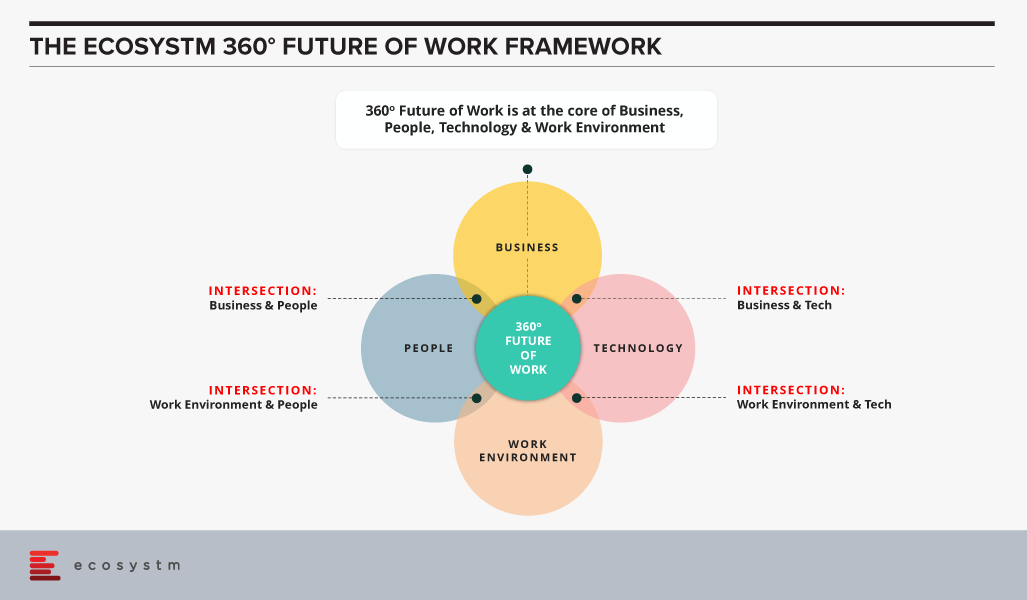
Here we focus on the Work Environment, and its intersection with the three other components.
Work Environment: A Component of the 360o Future of Work
Companies and people have learned work can be performed in many types of environments, just as business is conducted in varying venues. Each space will have a different impact and outcome. The three primary commercial areas are: office, industrial and retail. While industrial and retail commercial areas will be addressed later, we talk here primarily of the office environment. The office environment is designed to enable both collaborative and individual work. It has historically been densely packed. Post COVID-19, this environment will probably be modified. For the past few years, an alternative to the office environment has been co-working – a shared work environment with other companies, in open plan arrangements. It provides a way for business to save capital by minimising the expense of fit out. The combination of using both office and co-working environment is what will begin to be called “the Blended Environment”.
The Work Environment and its Intersections
While the Work Environment is an important component of the Future of Work, it is a co-enabler with Technology to support the People and Business.
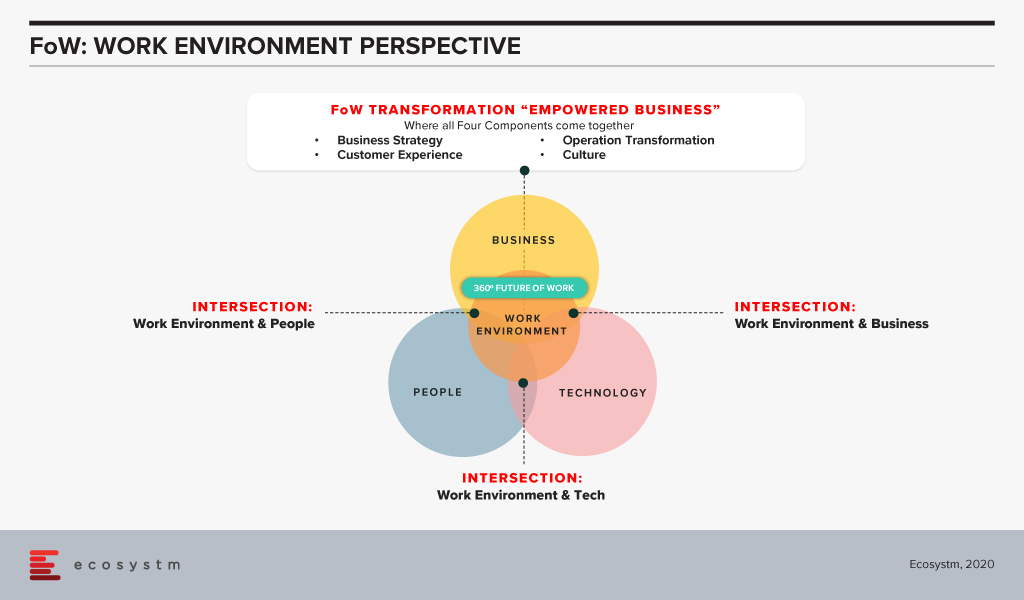
Work Environment – Intersection with the Business
The Business’s role is to provide Strategy and Direction. If done effectively it can take on unknown challenges. Examples of how the Business intersects with the Work Environment would be:
- Providing agility to the Business in preparing for any future crises. Some examples of how this can be done is by looking at how the space is controlled by the lease conditions, and how it is used by the occupants and the type.
- Aiding to minimise risk from excess space. An example would be space options for a lease. This will enable both spatial and financial flexibility for the company to expand or contract as needed.
Work Environment – Intersection with People
A critical component of the Empowered Business is its People – its workforce. For any company, the People are the key asset. They have to be able to grow and develop, in order to provide collaboration and idea creation. Examples of how the Work Environment can empower the People would be:
- The focus is on aligning the space with the employee’s task.
- The focus is on aligning where a person needs space to be effective, and the task the person needs to perform.
Work Environment – Intersection with Digital (Technology)
One of the important enablers of any Business, especially the Empowered Business, is its Digital Tools. They support the Business and its People, along with the Work Environment. They allow the Work Environment to be productive and effective. Examples of how Technology and the Work Environment intersect would be:
- This is where the two enablers (Digital Tools and Work Environment) work together to aid the employees and the business.
- This relates to how to manage the Business’s portfolio of space from a remote location.
These four components working together will enable an Empowered Business. The Work Environment as an enabler allows the Business to pivot, adapt, and thrive in the most challenging environment. It allows the Empowered Business to be better prepared to meet future crises head-on.
Schedule a time to speak with us on Future of Work
Ecosystm Principal Advisors; Tim Sheedy & Audrey William (Technology), Ravi Bhogaraju (People & Organisations), and Mike Zamora (Work Environment) provide a holistic view of what the Future of Work will look like.
We enable businesses to adapt, pivot and thrive in their ecosystem; provide holistic access to data and insight across People, Technology and Work Environment; help businesses transform and be better prepared for future disruption, and the ever-changing competitive environment and customer, employee or partner demands.
Contact us through the platform, or over email at info@ecosystm360.com



